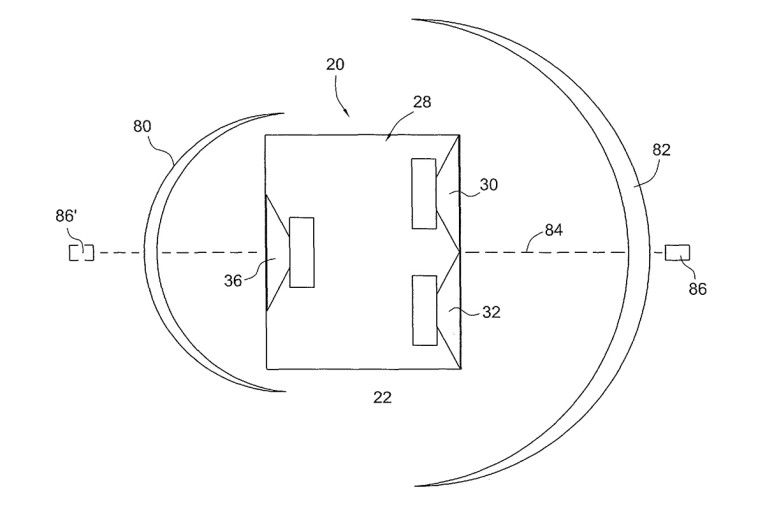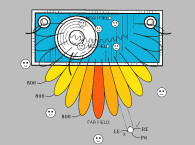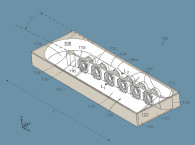
Bipolar Speaker with Improved Clarity
US Patent Number: 8995697
www.freepatentsonline.com
Inventors: Timothy Gladwin (Pakenham, CA) and Jason B. Cochrane (Arnprio, CA)
Assignee: Definitive Technology, LLC (Owings Mills, MD)
Filed: June 16, 2011
US Classes: 381/304
Publication: March 31, 2015
Number of Claims: 20
Number of Drawings: 27
Abstract from Patent
A forward focused bipolar loudspeaker system includes a front-facing driver array and a rear facing driver array with substantially identical front-facing and rear-facing midrange or mid-bass drivers voiced and driven so that the measured SPL curves of each of the arrays, when measured individually, are tonally balanced.
The front array and rear array have substantially identical on-axis and off axis frequency response and the rear array’s output power (SPL) is reduced by, preferably, about 6dB with respect to the output power produced by the front-facing array, while retaining a flat tonal balance for both the front and rear speakers, to produce a sound power ratio of about 2:1 as measured by comparing the front and back SPL levels of the speakers.
This bipolar speaker system and method for voicing was discovered to provide greater clarity and improved localization while retaining the spacious envelopment of the bipolar sound field.

Independent Claims
1. An improved bipolar loudspeaker system configured to provide improved localization, comprising: a first midrange or mid-bass loudspeaker mounted in a first front-facing baffle in an enclosure; a second midrange or mid-bass loudspeaker mounted in said first front-facing baffle in said enclosure, wherein said second midrange or mid-bass loudspeaker is substantially identical to said first midrange or midbass loudspeaker; a third midrange or mid-bass loudspeaker mounted in a second rear-facing baffle in said enclosure, wherein said third midrange or midbass loudspeaker is also substantially identical to said first midrange or mid-bass loudspeaker; wherein said first, second and third substantially identical midrange or mid-bass loudspeakers are thereby mounted in opposing front and rear facing baffles in said enclosure to create a bipolar speaker assembly; and said first, second and third substantially identical loudspeakers being interconnected to an audio signal source of power so that the rear sound power that is produced by the rear-facing third speaker is about 6 dB below the sound power produced by the forward-facing first and second loudspeakers, thereby improving localization while retaining the spacious envelopment of a bipolar sound field.
6. An improved, front or forward focused, bipolar loudspeaker system, comprising: (a) a front-facing loudspeaker driver array including at least a first midrange or mid-bass driver mounted in a front baffle in an enclosure; said front-facing array further including at least a first tweeter driver mounted in said front baffle in said enclosure; (b) a rear-facing loudspeaker driver array including at least a second midrange or mid-bass driver mounted in a rear baffle which opposes said enclosure’s front baffle; said rear-facing array further array further including at least a second tweeter driver mounted in said enclosure’s rear baffle; (c) a crossover configured to receive an audio signal from an audio signal source and connected to said front array drivers and said rear array drivers; (d) wherein said crossover, said front-facing array’s drivers and said rear-facing array’s drivers arc interconnected to said audio signal source so that when said audio signal source provides said audio signal, the rear array’s sound power is less than the front array’s sound power by a selected forward focused power ratio being in the range of 2dB – 10dB, thereby improving localization while retaining the spacious envelopment of a bipolar sound field.
18. A method of enhancing the sensation of spaciousness while preserving localization in a bipolar loudspeaker system, comprising: providing a loudspeaker system enclosure having a first front facing baffle or support surface opposing a second rear-facing baffle or support surface; mounting a first front-facing midrange speaker on said front facing baffle or support; selecting a second midrange speaker which is substantially identical to said first front-facing midrange speaker and mounting said second midrange speaker on said front facing baffle or support to provide a front facing array of substantially identical midrange speakers; selecting a third midrange speaker which is substantially identical to said first front-facing midrange speaker and mounting said third midrange speaker on said rear facing baffle or support to provide a rear facing midrange speaker which is substantially identical to the first and second front-facing speakers; connecting said first, second and third midrange speakers to a source of audio power to play together, thereby creating a bipolar speaker assembly; and driving said first, second and third midrange speakers from a common source of audio power so that the rear sound power that is produced by the rear-facing speaker is between 2dB and 10dB less than the sound power produced by the forward-facing speakers, thereby improving localization while retaining the spacious envelopment of the bipolar sound field.

Reviewer Comments
In 1987, the Mirage division of Audio Products International of Canada introduced a new loudspeaker called the M1, with duplicate transducer arrays mounted on the front and back baffles of the enclosure, and deemed the design a “Bi-polar” loudspeaker. This became the standard label for loudspeakers with equal, in-phase front and rear acoustic output.
Although this wasn’t the first speaker to have drivers arranged in this manner, it was the start of an approach that provided a sound field that had a popular following and inspired a number of imitators producing variations on the concept.
The M1 had a wide baffle that minimized half-wave interference cancellations appearing in the forward axis amplitude response due to the acoustic wavefronts of the rear firing transducers wrapping around the enclosure and mixing with the acoustic output from the front mounted transducers. Also, due to the substantially omni-directional radiation pattern, it increased the early reflections and room interaction, which caused a greater variance in sound quality, imaging specificity, and apparent clarity, depending on the listening room’s acoustical properties.
One of the next bipolar speaker systems was introduced in 1990 by a new company, Definitive Technology. For aesthetic reasons, Definitive Technology preferred its bipolar systems to have enclosures that were narrow and deep. With the narrow front and rear baffles, the acoustic output of the rear-mounted transducers was able to wrap around the cabinet and merge with the acoustic output of the front-mounted drivers at the listener position, causing undesirable half-wave cancellations and additional ripple in the axial response curve. To address this, Definitive Technology applied network tricks and even introduced a side-firing driver in an attempt to minimize the measurable and audible effects caused by interference (see US Patent 5887068).
In this recent patent, Definitive Technology, while still using the narrow form factor, has addressed the bipolar situation with a different solution. In the new system, a preferred front-to-back acoustical output balance is adjusted from being equal to a 2:1 ratio (about 6dB reduction) in the output of the rear firing transducers relative to the direct forward output. Ultimately, the rear output’s range of attenuation is defined as between 2 and 10dB, but the optimal amount is stated as –6 dB.
While there are several ways to achieve the attenuated balance, the preferred means disclosed is to either use dual drivers on the front of the enclosure and a single equivalent driver on the rear baffle, or to use one front and one rear driver and simply attenuate the rear driver signal in the crossover network by 6 dB. This attenuation of the rear driver output makes the rear energy weak enough that it no longer causes the rear-to-front half-wave interference that a balanced output does. Also, reducing the amount of energy radiating rearward, the reflected-to-direct sound ratio has been reduced, minimizing room interaction issues.
It is claimed that the reduction of the rearward radiation improves clarity and image localization while retaining the spatial envelopment of a bipolar sound field. It is unlikely that the spatial envelopment would remain equal to a balanced bipolar system, but the reduced room interaction and the resulting improvements in clarity and imaging should provide a net positive in sound quality and consistency for those preferring this type of loudspeaker format. VC
This article was originally published in Voice Coil, June 2015






